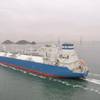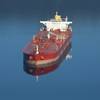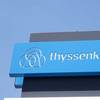One-on-One: Rob Langford, VP, Global Offshore Wind, ABS
As the U.S. offshore wind industry endures a predictable number of stops and starts during its adolescence, common mantras are ‘learn from the established European model’ and ‘embrace technology transfer from the offshore oil and gas sector.’ In Robert Langford, the American Bureau of Shipping has all of that and more bundled in one neat package.
Rob Langford has worked in the offshore industry for more than three decades, ‘cutting his teeth’ in a UK design firm working in the North Sea oil and gas platforms, the holy grail of rigorous conditions in offshore energy production. From that start he – like most other burgeoning leaders in the sector – became ‘mobile and global’, working with SBM in the floating offshore world with FPSOs and the turret business, then moving to New Orleans to work on Gulf of Mexico deepwater projects with Shell. Eventually he settled in Houston, working with engineering and advisory/EPC companies for offshore developments and another stint at SBM, which entailed project work globally.
About five years ago he made the switch over to offshore wind, working for Worley as senior director of offshore wind, and today he finds himself at ABS as the VP of Global Offshore Wind, a pivotal cog in helping to facilitate this emerging market globally.
Roadblocks on the Wind Path
Like most organizations in the maritime and offshore sectors, renewable energy and sustainability are a focus aread for ABS. “We are growing and evolving our services across all offshore infrastructure along with our continued support to the marine industry,” said Langford. “We continue to hire key individuals and partner to provide best-in-class solutions.”
Also – like most companies in the maritime and offshore sectors – today it is not possible for ABS to put a definitive number on ‘how fast, how far’ this business will grow. “It is difficult to provide quantitative figures as this is driven by the developers and approval regime,” said Langford. “However, we are gung ho about making this happen, and we are confident that the offshore wind business will grow year-on-year.”
While there are plentiful regulatory and environmental hurdles, they are not alone.
“One of the main risks I see is the onshore infrastructure to support fabrication, staging, O&M along with grid connectivity and PPA’s,” said Langford, noting that vessels to support installations are proving problematic, too.
From the government side, he sees a need for further support – incentives and subsidies – to develop ports and projects. “We need to help educate the local communities, helping them [especially government representatives] to better understand what we're trying to achieve,” said Langford. “Some of them do understand, but I think there's more work to do in that regard to meet the renewable energy goals.”
Is There Good News?
By its very nature, bad news sells, and there is no exception when it comes to offshore wind. At the end of ’23 rolling into 2024, the industry hit significant regulatory roadblocks – driven by environmental concerns, both real and manufactured – coupled with a rapidly changing economic situation [ie. runaway inflation] that caused several key stakeholders, early movers, to head for the exit. While the cost of project delays and cancellations have a real impact on the players that remain, Langford maintains an optimistic outlook long term.
“We are engaged with multiple US OSW wind developments and seeing an up-tick for CVA, technology review and risk reduction services in early development phases,” said Langford. “With new lease rounds coming and new opportunities, we do not see a big slowdown for OSW developments apart from the obvious project delays and re-bids.”
To date the U.S. has more than 30+ commercial scale projects underway and more to come, as BOEM approves more projects and lease areas. Virginia Offshore Wind and Revolution is in construction; Southfork is into installation, “so Orsted remains a key player in the U.S.”
“Equinor and BP obviously split the JV where Equinor takes the Empire Wind development and BP continues Beacon Wind,” said Langford. “New Jersey awarded a combined 3.7MW of offshore wind capacity to Invenergy, energyRE’s Leading Light Wind Project and Attentive Energy LLC’s Attentive Energy Projects in January 2024; all good signs for the industry. RWE and OceanWinds are also eager to push forward with their developments.”
Another good news story that could and should emerge is an energized U.S. shipbuilding and repair base, an orderbook packed with new ships and boats to feed this emerging market. While that has yet to transpire, Lanford assesses the potential.
“To meet the US offshore wind goal of 30GW by 2030, we see the demand of 5 to 7 installation vessels, 12 to 15 service operation vessels and 50 to 60 crew transfer vessels by 2030. Adding dredges, rock installation vessels, cable layers and feeder vessels, the U.S. Department of Energy estimates a total of 110 vessels.”
Currently two purpose-built Wind Turbine Installations are under construction, one the U.S.-flag WTIV Charybdis being built at Seatrium Amfels for Dominion Energy Coast Virginia offshore wind; and the foreign flag Maersk supply WTIV at Seatrium Singapore, together with U.S. flag feeder ATBs for transportation and installation of the Empire Wind. Three newbuild SOVs and three conversions/retrofits were awarded, too, and 22 CTVs were also announced. The first US rock installation vessel was ordered by Great Lakes Dredge & Dock Company, LLC.
Floating Future?
While the reality of widespread utility level floating offshore wind is still years away, it is generally acknowledged that floating wind is the future premised on its ability to operate further from shore to catch the stronger, more favorable winds. While the speed of technological development continues to pick up pace, Langford proposes that in the U.S. market, a correctly paced approach to suit supporting supply chain might be best in the long term. “It really boils down to further demonstrations … let's build it. But let's not try and do everything at once. The European model was more of a staged process in making things happen, and I think the U.S. can learn a fair bit from the European model. We're trying to do a lot all at the same time, and I think that's potentially problematic. Starting more demonstration projects would be a good path to success.”













